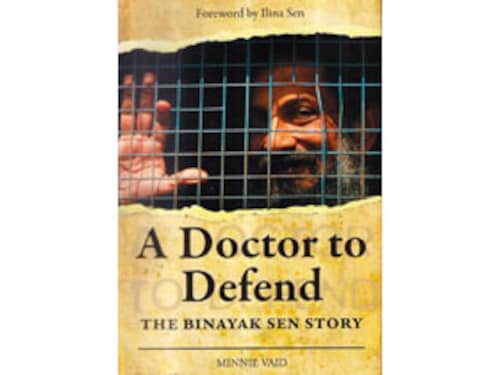Book Review: A Doctor to Defend - The Binayak Sen Story
A book that tells us who we are, what we might have been, and what we are afraid of


The Binayak Sen Story is really the story of contemporary Indian democracy. It tells us who we were, who we might have been, and what we are afraid of. It is a story that needs to be told over and over, and in as many different ways as possible. A Doctor to Defend is a welcome addition to what’s already been written about the man.
Minnie Vaid’s debut sets out to discover what makes Sen such a hero. While there is some information about the legal case, that’s not what the book is about. It is about Binayak Sen — student, colleague, bad cook, good doctor.
The prologue begins promisingly with the author confessing that she was disappointed initially: Sen didn’t look, sound or behave like the hero he is.
Unfortunately, her first chapter, which is given over to describing her meetings with Sen and his wife Ilina just after he had been granted bail, tells us little except that he is reluctant to talk about his newfound ‘hero’ status but that’s hardly surprising.
Chapter after chapter reiterates that Sen is the best kind of doctor any society can hope for. Readers are introduced to characters like maths whiz-turned-human rights lawyer Sudha Bharadwaj, who gave up an American passport to work with a trade union in Chhattisgarh, Dr. Saibal Jana, his wife Alpana, and many other doctors doing similar work in the state — ensuring health care is accessible to those who are least able to afford it. The next few chapters are full of memories of the ‘heady days’. They begin with Shankar Guha Niyogi, the assassinated leader who was instrumental in getting Sen to work in the area, and after whom his Shaheed hospital is named.
Vaid interviews several voluntary health workers — some of them have day jobs as mine workers — who have been trained at hospitals where patients have access to a bed for Rs. 5. Along with colleagues and friends, these people lend humanising details to the portrait of Sen and are evidence that the work he has been doing is not an emergency intervention. He was working towards a vision where medical services for the local community continue, whether or not he is available.
We learn some personal details about Sen, such as the fact that he always shared domestic chores with his wife that he once gave Rs. 10 to Dr. Jana for a haircut when the latter didn’t have enough that Ilina had to sell off her wedding sarees to make ends meet that his children fear him when he tries to teach maths that he once played a woman, complete with big breasts and hips, in a stage production called The Amorous Prawn. We also discover that he has always been driven to do more than what was expected from a doctor. As a student in Vellore, he would cycle miles to reach a village to hand over some additional medicine that he had forgotten to prescribe to a rural patient.
Despite this, one still doesn’t get a sense of Binayak, the man. Reading the book feels like trying to look for a vaguely familiar face on a foggy night. His intense privacy doesn’t allow the author an intimate look, for one. Secondly, the choice of format and structure doesn’t help.
Vaid begins at the beginning of her own journey — the first few interviews with the Sens, followed by interviews with lawyers, doctors, medical volunteers and patients in Dalli Rajhara, more interviews with doctors in CMC Vellore, the Rupantar interviews, the Raipur and Mumbai interviews (with Sen’s family), the Himanshu Kumar interviews. She does her own rich material a disservice by clubbing it in such a chronological or geographic fashion.
Chapters do not break where they should and there are stylistic annoyances, such as breaking up a single sentence into three paragraphs, like this:
‘…In an era where fighting injustice mattered.
Speaking up for the truth mattered.
Ideals and principles mattered.’
Even so, the book is essential reading for Binayak Sen fans (and his detractors too). It is also testament to the simple truth that Sen himself repeats over and over: His work is a part of a movement he is part of a circle of commitment that doesn’t think of their lives as a sacrifice, but as a ‘life of privilege’ instead.
Annie Zaidi is the author of Known Turf.
A Doctor to Defend: The Binayak Sen Story
Author: Minnie Vaid
Publisher: Rajpal
Price: Rs 350 PP: 243
First Published: Mar 23, 2011, 06:22
Subscribe Now